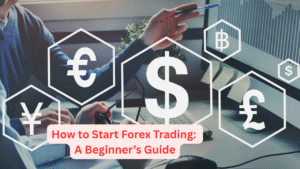 How to Start Forex Trading: A Beginner’s Guide
How to Start Forex Trading: A Beginner’s Guide
If you’ve ever wondered how to break into the world of Forex trading, you’re not alone. The global foreign exchange market attracts millions of beginners each year thanks to its 24-hour access, high liquidity, and low entry barriers. But before you place your first trade, it’s crucial to understand the basics of Forex, the tools you’ll need, and the steps to start trading responsibly. This beginner-friendly guide will walk you through how to start Forex trading the right way — with confidence and caution.
Step 1: Understand What Forex Trading Is
Forex trading (short for foreign exchange) is the process of buying one currency while simultaneously selling another, in hopes of profiting from fluctuations in exchange rates.
Currencies are traded in pairs (e.g., EUR/USD, GBP/JPY), and traders attempt to predict whether one currency will strengthen or weaken against another.
Key Forex terms to know:
- Base currency: The first currency in the pair (e.g., EUR in EUR/USD)
- Quote currency: The second currency in the pair (e.g., USD in EUR/USD)
- Pip: The smallest price move a currency can make
- Spread: The difference between the buy (ask) and sell (bid) price
- Leverage: The ability to control a large position with a small deposit
Step 2: Choose a Regulated Forex Broker
A Forex broker gives you access to the market via a trading platform. Your broker executes trades on your behalf, provides pricing data, and may offer educational tools or account support.
How to choose a broker:
- Look for regulation by authorities like the FCA (UK), ASIC (Australia), or NFA (U.S.)
- Compare spreads, commissions, and leverage options
- Test their platform usability (like MetaTrader 4 or 5)
- Read independent reviews and test a demo account
Tip: Avoid offshore, unregulated brokers — many are scams or unreliable.
Step 3: Open and Fund Your Trading Account
Once you’ve chosen a trustworthy broker:
- Fill out an online application
- Verify your identity (usually requires photo ID and proof of address)
- Choose your account type (standard, mini, or micro)
- Fund your account via bank transfer, credit card, or e-wallet
Many brokers let you start with as little as $100, though more capital allows better risk management.
Step 4: Use a Demo Account to Practice
Before risking real money, open a demo account to get hands-on experience with the trading platform.
A demo account simulates real market conditions using virtual funds — ideal for testing your knowledge and refining strategies.
Practice:
- Placing trades (buy/sell)
- Using stop-loss and take-profit orders
- Analyzing charts and indicators
- Managing your risk per trade
Pro Tip: Treat demo trading like real money trading to build proper discipline and decision-making habits.
Step 5: Learn the Basics of Analysis
Successful Forex trading involves analyzing market conditions using two main approaches:
1. Technical Analysis
Involves studying charts, price patterns, and indicators (like moving averages, RSI, MACD) to forecast future price movements.
2. Fundamental Analysis
Focuses on economic data (interest rates, inflation, GDP, employment) and geopolitical events that impact currency values.
You don’t have to master everything at once — start with a few simple indicators and gradually expand your toolkit.
Step 6: Create a Trading Plan
Jumping into the market without a plan is a fast way to lose money.
Your trading plan should include:
- Your preferred currency pairs
- Trading style (day trading, swing, scalping)
- Entry and exit rules
- Risk per trade (typically 1–2% of account)
- Stop-loss and take-profit strategies
- Hours you plan to trade
Consistency is key — don’t change your strategy impulsively.
Step 7: Start Live Trading with Small Risk
Once you’re confident in your demo results, you can move to a live account — but start small.
Tips for your first trades:
- Stick to major currency pairs (like EUR/USD or GBP/USD) for lower spreads
- Use low leverage (10:1 or less) to reduce risk
- Always use a stop-loss
- Avoid trading during high-impact news events until you’re experienced
Track your results using a trading journal to identify what works and what doesn’t.
How to Start Forex Trading: Final Thoughts
Starting Forex trading can be exciting — but without preparation, it can quickly lead to losses.
By understanding the fundamentals, choosing a trusted broker, practicing on a demo account, and building a solid trading plan, you’ll set yourself up for long-term growth and confidence in the markets.
Remember: Forex success isn’t about getting rich overnight. It’s about mastering the process — one step at a time.
Explore more beginner-focused insights in our Forex Trading Insights section to guide your journey.
How to Start Forex Trading:FAQs
1. How much money do I need to start Forex trading?
You can start with as little as $100, but most experts recommend at least $500–$1,000 to allow for better risk control.
2. Is Forex trading legal for beginners?
Yes, Forex trading is legal in most countries. Just make sure to use a regulated broker in your region.
3. Do I need a degree or license to trade Forex?
No formal education or license is required. However, self-education is essential. Read guides, watch tutorials, and practice often.
4. How long should I use a demo account?
Use it until you feel confident with your strategy and consistent in your results — typically 1 to 3 months for beginners.
5. Can I trade Forex on my phone?
Yes. Most brokers offer mobile apps (like MetaTrader) so you can monitor trades and manage your account on the go.
